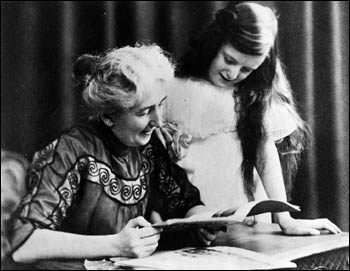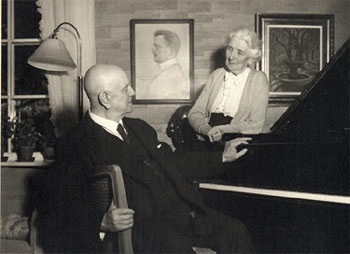Aino Sibelius (1871-1969)

Aino Sibelius teaching her daughter Katarina at Ainola during the period 1910-1920
Aino Sibelius lived in Ainola from the autumn of 1904 up to end of the 1960s, when illness forced her to spend the remaining months of her life in hospital.
The first years in Järvenpää were hard for Aino. With her own hands she transformed a stony clump of alders into a garden. The work in the garden also helped her to forget the worries caused by her husband's drinking and partying lifestyle. "I was constantly hoeing and shovelling. Now and then I cried and then I started hoeing again," she said later. In 1907 Aino needed a period of convalescence at Hyvinkää Sanatorium. "During the first years Mother was probably so stressed because of the financial situation that she didn't have much energy left," Katarina Ilves later recollected.
In addition, her responsibilities as a teacher weighed heavily on her. Initially, Aino taught her daughters herself, and they did very well after they began regular schooling. During the lessons, as Katarina put it later, "Mother was not mother. She was the teacher, and she had to be respected. In other ways, too, we had tremendous respect for her."
Aino's "happiest years" began in 1908, when Jean Sibelius gave up alcohol for almost seven years after a throat operation. The family grew with the addition of Margareta in 1908 and Heidi in 1911. By this time Aino was 40 years old.
Ainola was not really an obvious place to settle down. Indeed, in 1912 the family was planning to move away, one factor being that relations between Aino and her neighbour Saimi Järnefelt had temporarily become strained. Nevertheless, Ainola remained the family stronghold: it was given up only for a couple of months in 1918, when the family had to move to Helsinki because of the Civil War. Aino Sibelius's vegetable garden turned out to be an important resource when the family had to be fed during the shortages caused by World War I and the Civil War.
When the last of the children had moved away from home in the 1930s, Aino Sibelius wanted to be in Helsinki, to be near her daughters and to be able to attend concerts and theatrical performances. In the summer of 1939 the Sibeliuses rented a town apartment in Kammiokatu (today Sibeliuksenkatu, Sibelius Street), but in October of that year the outbreak of the Winter War with Russia prompted them to move back to Ainola. From the autumn of 1940 until the summer of 1941 the family again lived in Kammiokatu, but in the summer of 1941 relations between Finland and the Soviet Union once again became so strained that people were asked to take their children away from Helsinki because of the risk of bombing. The Sibeliuses and their numerous grandchildren moved to Ainola. The Continuation War started on 22nd June 1941. After that the Sibeliuses gave up all thoughts of moving away from Ainola.

During the last decades at Ainola, Aino continued to devote herself to her husband, her family and her vegetable garden. "My wife's whole life has been dominated by a sense of duty," Jean Sibelius said to his secretary in the 1940s.
Yet life was not lacking in romance: Katarina Ilves later recollected that in Ainola her parents would often start dancing without music. And in the morning of Aino's 85th birthday, on 10th August 1956, the 90-year-old composer came to "woo" his wife a second time on the upper floor of Ainola. He was carrying a large bouquet of roses, even if he had trouble climbing the steep stairs.
After Jean Sibelius's death Aino Sibelius continued to live at Ainola. She arranged family documents and helped Santeri Levas and Erik Tawaststjerna when they were writing their biographies of Sibelius. Aino Sibelius died on 8th June 1969, aged almost 98.
Read Aino Sibelius's Memories of Ainola

































